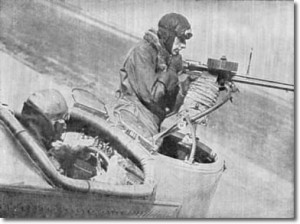The major combatants were soon producing aeroplanes in ever-increasing numbers, both by state-run manufacturers and emergent private constructors. Chief among those in the UK was the Royal Aircraft Factory and Sopwith – in Germany there was LVG and Fokker; in France, Farman and Voisin. These companies, and many more like them, all began beavering away to develop improved designs and innovations to help their airmen counter each other more effectively. One obvious way forward was for them to carry stronger armament and the weapon of choice was the most deadly, modern and efficient of them all – the machine gun. For the Germans it was a fairly simple matter of out-fitting their rear-seated observers with a flexible gun mounting; for the French fixing the movable weapon to the bow of their aeroplanes’ nacelles; indeed it befell a French Voisin crew to record the World’s first air-to-air victory, by shooting down a German Aviatik over the Marne in early October. For the Royal Flying Corps squadrons flying the BE2, the situation was far less straightforward. Even in the improved BE2c version, the observer’s position was unchanged. He remained in the front cockpit and his guns went there too, usually for the ride, as firing effectively from that restrictive position was virtually impossible.

